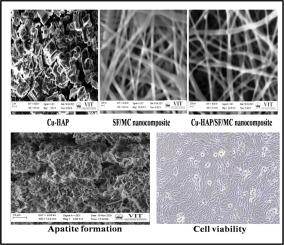Fabrication of copper ion-substituted hydroxyapatite/Silk fiber/Methylcellulose composite: mechanical, antimicrobial, hemocompatibility, bioactivity and cytocompatibility evaluation
IF 2.5
Q2 CHEMISTRY, MULTIDISCIPLINARY
引用次数: 0
Abstract
Herein, we reported the preparation of copper substituted hydroxyapatite (Cu-HAP) and fabrication of electrospun composites using Cu-HAP, SF (Silk fiber) and MC (Methylcellulose) by E-Spin method. Characterization techniques such as XRD (phase formation), FTIR (chemical bonds), SEM and EDAX (surface morphology and elemental composition) were carried out. Porosity measurement, swelling and mechanical properties were carried out to investigate the physicochemical properties of the fabricated electrospun composites. The hemocompatibility analysis indicated a hemolysis ratio < 2 %, which confirms the blood compatibility nature of the composite. Antibacterial activity of Copper hydroxyapatite/silk fiber/ Methylcellulose electrospun composite showed estimable activity against E.coli (zone of inhibition: 46 ± 0.94 mm) compared with pure SF/MC electrospun composite (33 ± 1.21). Bioactivity study confirmed the development of bone-like apatite on the surfaces of optimized (SF/MC 30 wt% of Cu-HAP) electrospun composite. Furthermore, MG63 cells were utilised to study the biocompatibility of the enhanced electrospun composite and good cell viability (99.93 ± 0.12 % using 25 μg/mL) was observed from microscopic image and the results showed that 30 wt% of Cu-HAP added polymer composite has outstanding osteoinductivity, biocompatibility, and antibacterial results, making it a very valuable aspirant for use in bone tissue engineering (BTE) applications to repair bone defects.

制造铜离子取代的羟基磷灰石/蚕丝纤维/甲基纤维素复合材料:机械、抗菌、血液相容性、生物活性和细胞相容性评估
在此,我们报道了铜取代羟基磷灰石(Cu-HAP)的制备,以及使用 Cu-HAP、SF(丝纤维)和 MC(甲基纤维素)通过 E-Spin 法制造电纺复合材料。表征技术包括 XRD(相形成)、FTIR(化学键)、SEM 和 EDAX(表面形态和元素组成)。为了研究电纺复合材料的物理化学特性,还进行了孔隙度测量、溶胀和机械特性研究。血液相容性分析表明溶血率为 2%,这证实了复合材料的血液相容性。与纯 SF/MC 电纺复合材料(33 ± 1.21)相比,羟基磷灰石铜/蚕丝纤维/甲基纤维素电纺复合材料对大肠杆菌的抗菌活性(抑菌区:46 ± 0.94 mm)可估计。生物活性研究证实,优化的(SF/MC 30 wt% Cu-HAP)电纺复合材料表面形成了类骨磷灰石。此外,还利用 MG63 细胞研究了增强型电纺复合材料的生物相容性,从显微镜图像中观察到良好的细胞存活率(使用 25 μg/mL 时为 99.93 ± 0.12 %),结果表明,添加 30 wt% Cu-HAP 的聚合物复合材料具有出色的骨诱导性、生物相容性和抗菌效果,使其成为骨组织工程(BTE)应用中修复骨缺损的非常有价值的材料。
本文章由计算机程序翻译,如有差异,请以英文原文为准。
求助全文
约1分钟内获得全文
求助全文

 求助内容:
求助内容: 应助结果提醒方式:
应助结果提醒方式:


